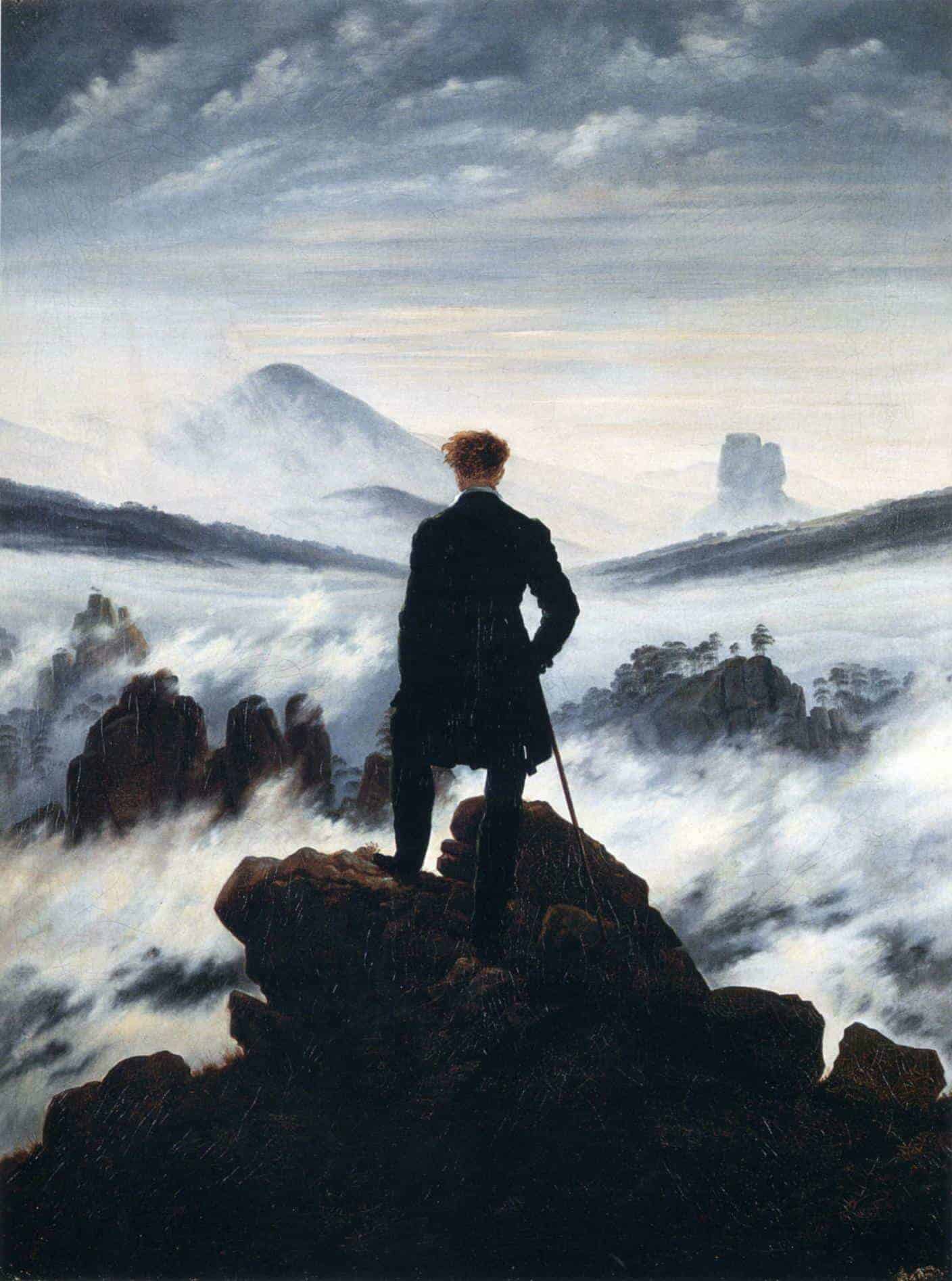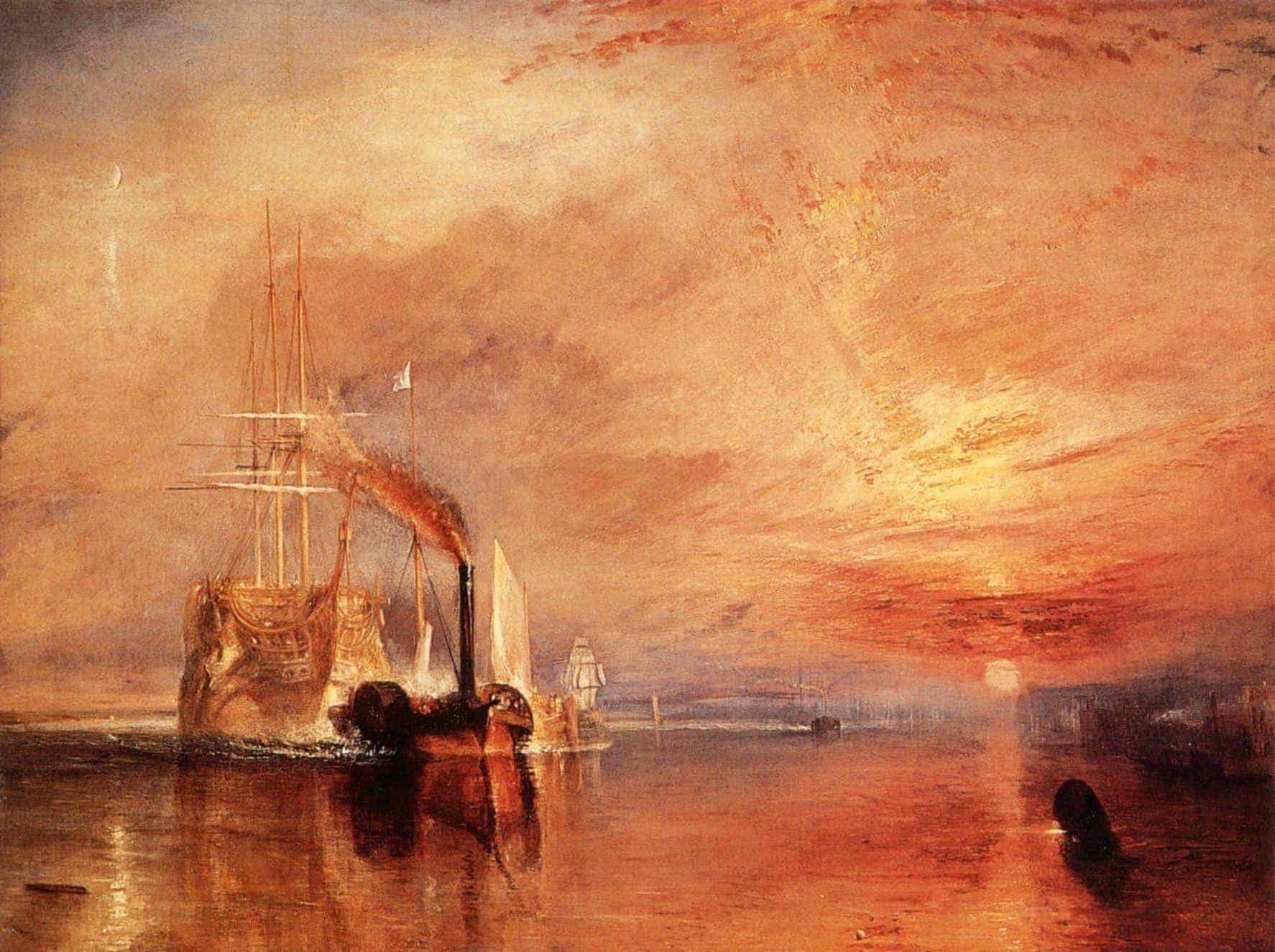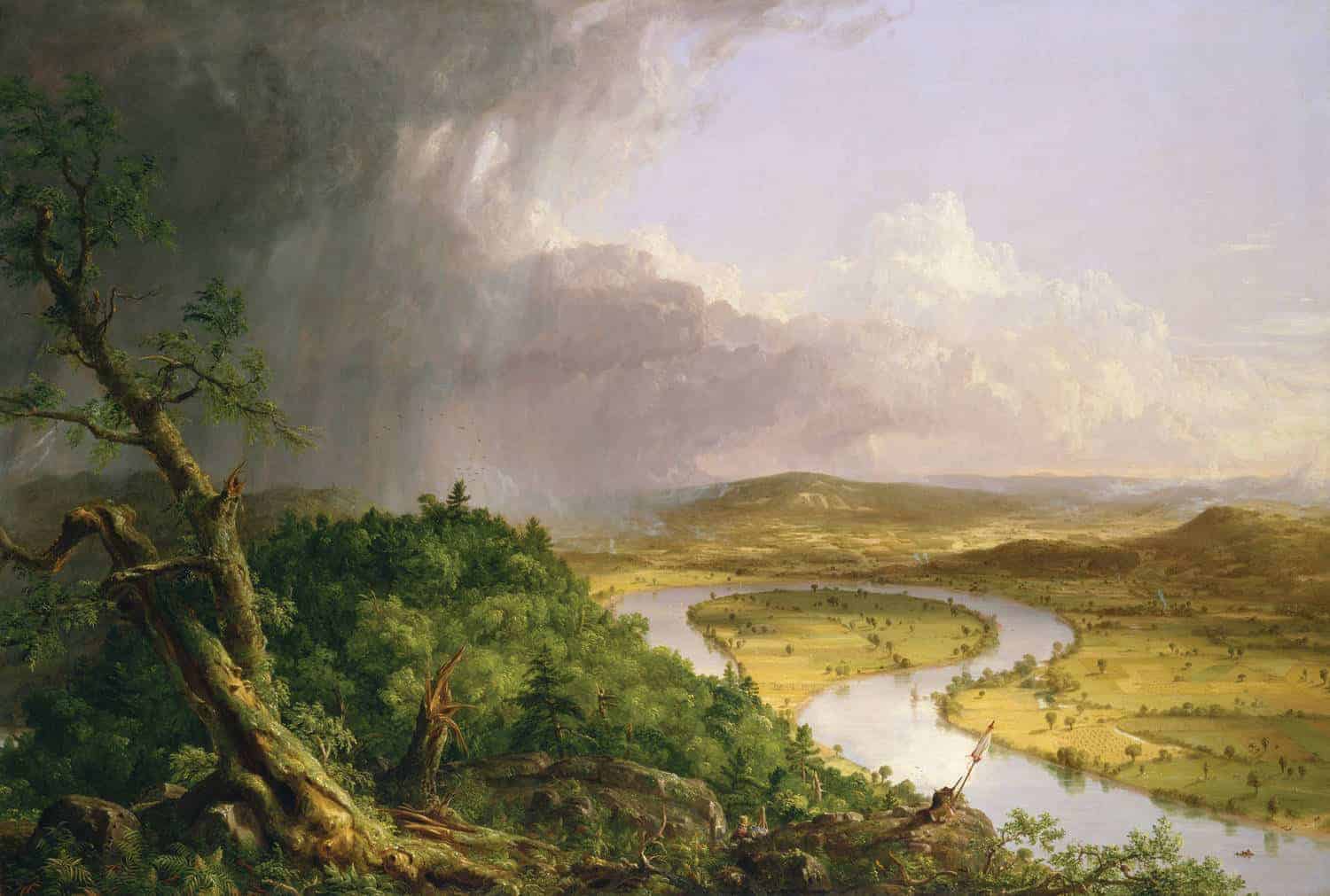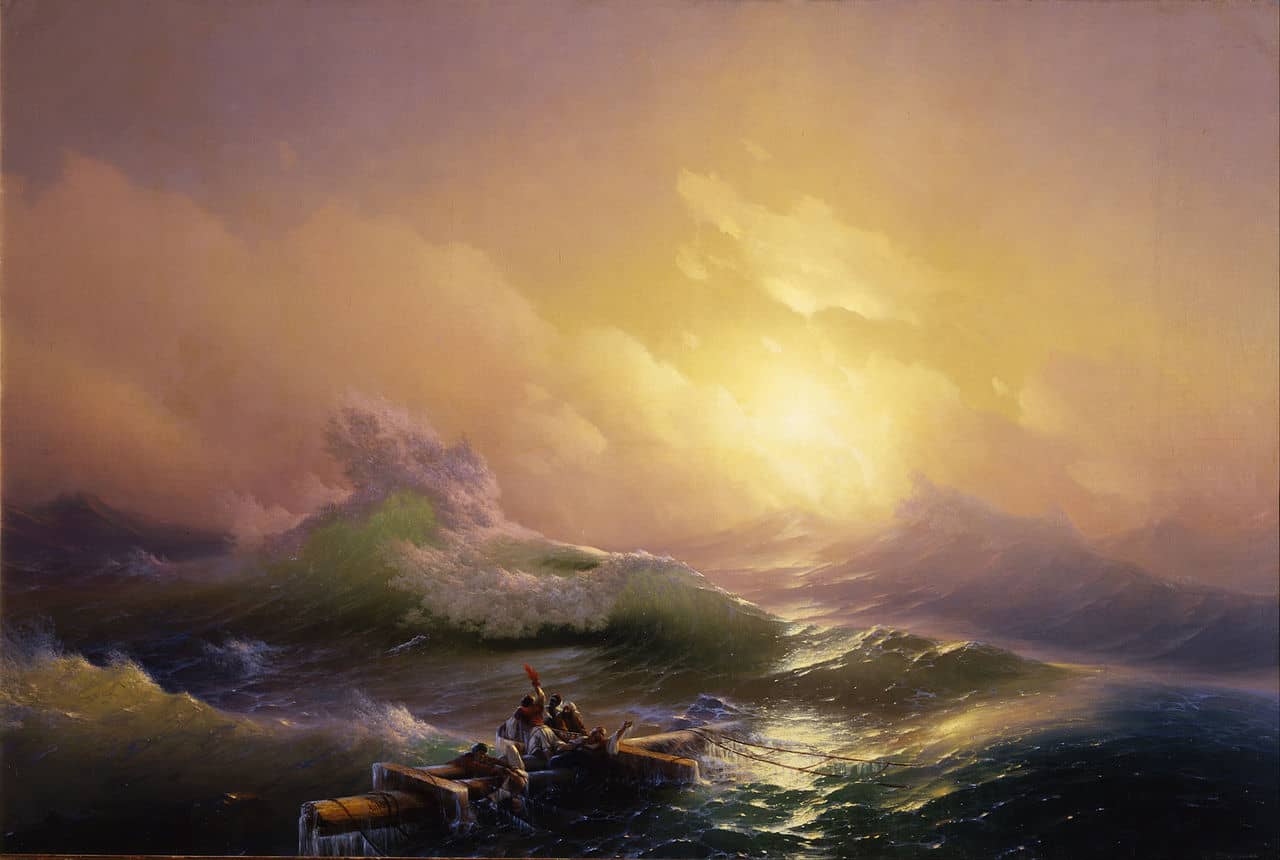The Enlighteenmt and the the American Revolution the Light Delicate Style of Art Called
Definition of Romanticism
Romanticism (likewise the Romantic era or the Romantic catamenia) is an creative, literary, and intellectual movement that originated in Europe toward the terminate of the 18th century and was at its superlative in the approximate period from 1800 to 1850.
Romanticism is characterized past its emphasis on emotion and individualism as well every bit glorification of all the past and nature, preferring the medieval rather than the classical. It is a reaction to the ideas of the Industrial Revolution, the aristocratic social and political norms of the Age of Enlightenment, and the scientific rationalization of nature.
The meaning of romanticism has changed with fourth dimension. In the 17th century, "romantic" meant imaginative or fictitious due to the nascence of a new literary genre : the novel. Novels, that is to say texts of fiction, were written in colloquial (romance languages), equally opposed to religious texts written in Latin.
In the 18th century, romanticism is eclipsed by the Age of Enlightenment, where everything is perceived through the prism of science and reason.
In the 19th century, "romantic" means sentimental : lyricism and the expression of personal emotions are emphasized. Feelings and sentiments are very much present in romantic works.
Thus, then many things are called romantic that information technology is difficult to see the common points betwixt the novels by Victor Hugo, the paintings by Eugène Delacroix or the music by Ludwig Von Beethoven.

The romantic international
Romanticism is not limited to 1 country, it was an international vision of the world.
The romantic international started in Germany at the cease of the 18th century with "Storm and Stress". The ii nearly famous poets are Goethe and Schiller and many philosophers such as Fichte, Schlegel, Schelling and Herder.
Romanticism was then adopted in England. Poets are divided in two generations :
- first generation : William Blake, William Wordsworth, Samuel Taylor Coleridge.
- second generation : George Byron, Percy Shelley, John Keats.
Romanticism reached France at the get-go of the 19th century with François-René de Chateaubriand – Atala (1801), René (1802), Le Génie du Christianisme (1802) – and Germaine de Staël : De l'Allemagne (1813).
Romanticism was a renewal, a revolution is artistic forms in paintings, literature and theatre. In Germany and Russia, romanticism created the national literature. It influenced the whole vision of art.
It was also the origin of contemporary ideas : modern individualism, the vision of nature, the vision of the work of fine art as an isolated object.

Political dimension : the birth of Romanticism
Romanticism represents a break with the universalistic outlook of the Enlightenment. Reason is something universal and the Enlightenment institute its models in classical French republic and Rome : all men are the same considering in that location are all reasonable. Romanticism if a fragmentation of consciousness, with no universalistic ideas left.
The French Revolution was characterized past universalistic ideas such as all men are created equal. It corresponds to the philosophy of the Enlightenment. The nation is born out of a social contract : it ways that you are free to choose to belong to one nation or another.
Information technology is dissimilar in Germany where you don't choose your state, that is where you were built-in (organic nation).
There'south a difference between the first and second generation of poets. British poets were rather progressive and shut to dissenters.
The French Revolution was total of hope of equality only it quickly changed when in 1793, it gave way to the Terror and the beheading of the Rex.
The first generation of British romantic poets
Simply William Blake remained a radical, different Wordsworth and Coleridge. There was an incredible pressure in England at the fourth dimension. The Prime Minister, Pitts, suspended the Habeas Corpus and adopted the Sedition Act, which was meant to prevent the freedom of press. It turned away the first generation from their ideals.
Blake wrote a visionary, imaginary verse, really hard to understand. Wordsworth and Coleridge were reactionary to the French Revolution.
Wordsworth turned away from the excesses of the revolution and wrote a simple poetry in a democratic mode.
Coleridge was inspired past the Middle Ages and German thought and was a reactionary Christian nationalist.
The second generation of British romantic poets
The second generation remains more radical only the political climate was so oppressive that the radicals left England or fabricated more indirect political comments.
The Mask of Anarchy by Shelley was inspired by the Peterloo Massacre of 1819. In Prometheus Unbound, a homo fights against political and religious oppression.
Romanticism was connected with politics of the time. Romantic poets could be either conservative or progressive, depending on their vision of the world.
Primary romantic themes
From society to nature
At that place is an intellectual shift from society to nature. During the Enlightenment, thinkers had a metropolitan consciousness: the intellectual life took identify in cities – London and Edinburgh were highly-regarded cultural centres.
The Enclosure Movement
Nature was idea as humanized, transformed by man with agriculture. The Enclosure Movement was a push in the 18th and 19th centuries to take land that had formerly been owned in common past all members of a village, or at least available to the public for grazing animals and growing nutrient, and change it to privately owned state, usually with walls, fences or hedges around information technology.
The most well-known Enclosure Movements were in the British Isles, but the practise had its roots in the netherlands and occurred to some degree throughout Northern Europe and elsewhere equally industrialization spread.
Some pocket-size number of enclosures had been going on since the 12th century, specially in the n and west of England, but it became much more common in the 1700'due south, and in the next century Parliament passed the Full general Enclosure Act of 1801 and the Enclosure Act of 1845, making enclosures of sure lands possible throughout England, Wales, Scotland, and Ireland.
The English authorities and elite started enclosing land claiming it would allow for amend raising of crops and animals (particularly sheep for their wool).
They claimed that large fields could exist farmed more than efficiently than individual plots allotted from common land — and the profit could exist kept by the aristocrats who now owned the legally confiscated country. Some merits this was the beginning of commercial farming.
Poor people had no style of subsistence apart from working for the land owners. It brought about more poverty and poor people drifted from the countryside to the cities, where the Industrial Revolution had begun, based on the steam engine and the creation of factories where poor people were employed in bad working conditions, pollution, criminality and corruption.
The paradox was that more and more people moved into the cities when they all had terrible living conditions.
An idealization of nature
Nature became idealized as life in the state was more virtuous. Romantic poets did not talk about cities (merely realists did). Nature was a source of poetic inspiration and gave a spiritual dimension to life, based on the organic connection between man and nature in traditional rural society, which was dying fast because of the Industrial Revolution (opposition betwixt the organic/natural and the mechanical engineering).
There was a regeneration of human life destroyed by cities, an idealized vision of nature : they were looking for a renewed humanity.

later a Thunderstorm (1836)
Wordsworth and Coleridge left the city for the Lake Commune. In America, transcendentalists such as Emerson or Thoreau did the same. Thoreau went out in the wilderness to Walden Pond to write Walden in 1854.
They discovered the American identity : the civilisation was European. There is a kind of individualism that refuses every kind of moral convention (who y'all really are) and pantheism (conventionalities that Nature is divine and has a soul).
The expression of personal feelings, energy and passion
Nature was non only peaceful and meditative but besides stormy, tempestuous and also big for human (sublime).
In Shelley's Ode to the W Air current, the poet starts by identifying himself with the wind : he wants to have the same power and the aforementioned freedom. Equally such, information technology can be considered a political verse form. The "w wind" is the air current from America, from the Revolution.
The romantic world is a dynamic world of change. When there is beauty, it's ever ephemeral. What creates the changes are the elemental forces (tempest, power, etc).

Energy tin can come up from human beings as well. Romanticism is the accent of feelings, passions and intuitions. It differs from the 18th century, which was based on reason and reflection.
Reason is universal, everyone uses the aforementioned logic : it is not personal. On the other hand, feelings, passion and intuition are what make people different from each other; it is very individualistic and selfish.
Passion is ane of the dynamic elements of romanticism, it's a factor of change for the private and a gene of historical alter as Hegel once said "cipher swell was achieved in history without passion".
Passion is also extremely irresolute : nada is closer to honey than detest. Information technology alternates between exaltation and melancholy, between nostalgia and optimism.
I am certain of goose egg merely of the holiness of the centre's affections and the truth of imagination.
John Keats
The romantic vision of honey is best considering intense when incommunicable : destiny, expiry, social differences – every bit in Romeo and Juliet.
Keats' Isabella or the Pot of Basil happens in the Middle Ages in Italy. The lover is killed by Isabella's brothers. She digs his grave, cuts his caput and hides it in a pot of basil with a flower in it. As she cries everyday, it turns to a beautiful flower. Information technology is Bocaccio'southward story and Stendhal'southward Le Rouge et le Noir : a connection between dear (Eros) and death (Thanatos).
According to Nietsche, passion is "beyond good and evil", it does not care virtually morality.
A dualistic world
Contrasts, dichotomies can be seen on all levels between reason and emotion, beautiful and sublime, reality and imagination.
Dialectics are the dynamic principle behind everything and could be seen every bit a rational monism (the antonym of "pluralism") with the religious revival and the visionary style. E.thousand : Wuthering Heights by Emily Brontë, Jane Eyre by Charlotte Brontë, Anne Grayness past Anne Brontë.
Wuthering Heights takes place in Yorkshire moors. Catherine Earnshaw hesitates between Heathcliff and Edgar Linton. She chooses Edgar but Heathcliff comes dorsum rich. There is a conflict betwixt what men represent and what places represent. It'south the disharmonize of "the children of calm, the children of the tempest".
The dualism is a cosmic affair between calm and quietness, storm and passion. It'southward the idea of human duplex : man is double in a "double simultaneous postulation".
A rediscovery of history and exoticism
There is a rediscovery of history and exoticism through local colour : few details to bear witness you are not at dwelling house (for instance, if you write about Asia, add some geishas in kimonos).
With romanticism, there is an outburst of cultural nationalism : German romanticism was a flowering of colloquial literatures. The colloquial is the language spoken by the people; it's unlike from the language spoken by the cultural elite (French, Latin). It was proficient plenty to produce practiced literature. There was also a going dorsum to folklore, legends, and fairy tales.
Wordsworth and Coleridge both wrote lyrical ballads in 1798. In The Rhyme of the Aboriginal Mariner, Coleridge worked on the supernatural and tells the story of a mariner who killed an albatross, which is a very bad omen for mariners : they are all doomed.
In The Idiot Boy, Wordsworth dealt with the ordinary life and tells the story of a woman who needs medicine for her child. She sends the idiot boy. His aim was to correspond the essential passions of human being nature, to use simple language, "the select of a language, really used by men". He abandoned the artificiality of poetic wording and the political dimension criticized by many people.
Wordsworth likewise wrote "conversation poems" such as Frost as midnight: blank verse monologues addressing the listener as in a chat. The listener is in fact the reader.
Regional verse is another way to utilize the vernacular : vernacular in Scotland is different from the vernacular in South England. Come across Walter Scott and Robert Burns.
Walter Scott invented the historical novel with Waverley (1814) and Ivanhoe (1819). He gave a sense of history with accurate details and characters' destinies influenced by historical faces. The plot tells a clash of values, of choices made in a crucial moment by a young and romantic human, through the arcadian image of a united nation. Scott tried to show reconciliation between idealism and reality.
In the USA, James Fenimore Cooper'south The Last of the Mohicans (1826) tells nigh the disharmonize between France and Great britain in the American colonies. The image of the Native American is that of a noble savage, yet a "vanishing Indian" because of the progress of the American civilisation.
Aesthetic dimension
Meet Todorov's Théories du Symbole (1977). Romanticism emphasizes imagination (as opposed to the 18th century).
Before, art was imitation and mimesis (cf. Aristotle). There was a process of selection of things that were worth representing and a correction of nature according to the image of dazzler you had in mind (harmony in parts and whole).
On the other mitt, with romanticism, art is cosmos; it'southward an democratic whole. It does non imitate nature but recreates it. It is not a mirror only a different reality. This parallel world is based on the necessary artistic relations between the dissimilar organic parts.
Thus, it is useless, there is no purpose except of recreating reality. It is gratis, autonomous, unlike before when it was made to instruct and entertain with a moral quality. There is no morality in art for the romantics.
Like nature, a piece of work of art is an organic totality in form and meaning. The faculty it creates is imagination. Coleridge defined fancy and imagination in The Biographia Literaria, one of his main critical studies.
Imagination is an artistic and secondary imagination. It's the principle of unity in a piece of work of fine art and assimilates into a unifying vision. Principal imagination is the basis of perception and God-like quality:
The IMAGINATION so, I consider either as primary, or secondary. The principal IMAGINATION I hold to be the living Power and prime number Agent of all human Perception, and equally a repetition in the finite mind of the eternal act of creation in the space I AM. The secondary Imagination I consider every bit an repeat of the old, co-existing with the conscious will, still still every bit identical with the primary in the kind of its agency, and differing only in degree, and in the mode of operation. It dissolves, diffuses, dissipates, in guild to recreate; or where this procedure is rendered incommunicable, however still at all events information technology struggles to idealise and unify. Information technology is essentially vital, fifty-fifty as all objects (as objects) are essentially stock-still and dead.
Fancy is associational logic, you practise not create but acquaintance ideas :
FANCY, on the contrary, has no other counters to play with, only fixities and definites. The Fancy is indeed no other than a mode of Retention emancipated from the club of time and space; while it is composite with, and modified by that empirical phenomenon of the volition, which we express by the word CHOICE. Merely equally with the ordinary retention the Fancy must receive all its materials ready made from the law of association.
In Coleridge's Kubla Khan (1816), there's a dissimilarity between microcosm and macrocosm : the union of contraries makes a synthetic whole thanks to symbols, polysemy and allegories.
In Herman Melville's Moby Dick (1851), the white whale is an albinos and there is an opposition between nature and homo (captain Ahab) showing the irreducible forces of nature.
The image of the artist can have several forms. He can be like a God, a creator but it comes with strings attached such as the trouble of transgression or curse.
If you are like a God, you're likely to get punished for your hubris or your disobedience to the cosmic laws, just similar Prometheus. The artist can also prefer the image of the "poète maudit".
Source: https://www.skyminds.net/the-19th-century-romanticism-in-art-and-literature/
0 Response to "The Enlighteenmt and the the American Revolution the Light Delicate Style of Art Called"
Publicar un comentario